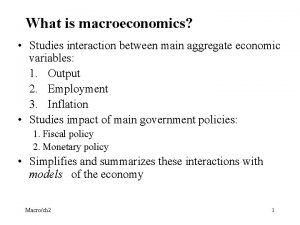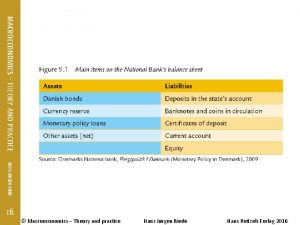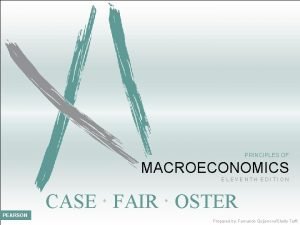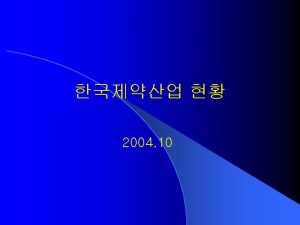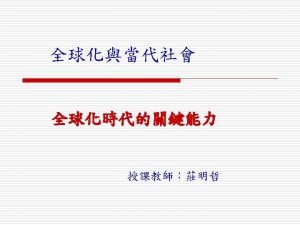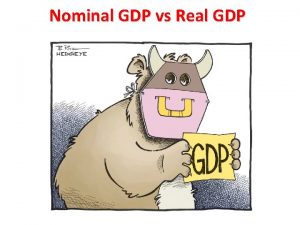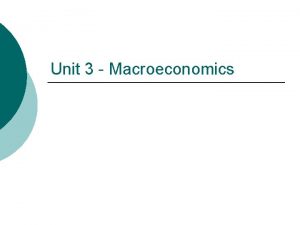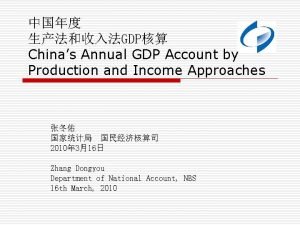6 Introduction to Macroeconomics and GDP Previously Health




















































- Slides: 52

6 Introduction to Macroeconomics and GDP

Previously • Health expenditures in the United States are 15. 8 percent of national economic output (more than any other nation). • Asymmetric information exists when one party in a transaction knows more than the other does. This can take on three forms: adverse selection, moral hazard, and the principal-agent problem. • Rationing medical care is a fact of life since we live in a world of scarcity.

Misconception • Misconception: – There is no reliable way to determine how well an entire economy is performing. • Economists often disagree about the state of our economy. • However, there is an objective and reliable measure of macroeconomic performance—and this is the primary focus of this chapter.

Big Questions 1. How is macroeconomics different from microeconomics? 2. What does GDP tell us about the economy? 3. How is GDP computed? 4. What are some shortcomings of GDP data?

Macroeconomics versus Microeconomics • Macroeconomics • Microeconomics – Economy-wide issues – Aggregate-level • Inflation • Unemployment • Economic growth – Individual-level decisions – Households or firms • Individual markets • Choices • Implications for P and Q

Macroeconomics and GDP • Gross domestic product (GDP) – Total (gross) amount of everything produced within a specific economy – Used to analyze economic growth – Can compare regions or nations • Note: some quality-of-life measures are not easily captured quantitatively.

Defining GDP • Gross domestic product – The market value of all final goods and services produced in a nation within a specific period of time. – Sum of output from all economic activity • Output = GDP = Income

Measuring GDP in Slate’s “What Is GDP? ” • Economic Growth and GDP – What does GDP represent? – Can a country’s entire economy be summed up in one number?

Three Uses of GDP Data • Why is GDP useful to examine? 1. Estimate living standards across time and nations 2. Measure economic growth 3. Determine whether an economy is experiencing a short-run expansion or recession

Practice What You Know— 1 • Gross domestic product (GDP) also measures A. a nation’s exports. B. a nation’s debt. C. a nation’s income. D. a nation’s consumption.

Measuring Living Standards— 1 • Total GDP: – Not as accurate for cross-country comparisons – Does not adjust for population size of country

Measuring Living Standards— 2 • 2013 GDP (billions of $) 2013 GDP per capita ($) China 9, 240 6, 807 Germany 3, 730 46, 269 Country

Measuring Living Standards— 3

Measuring Economic Growth U. S. Per Capita Real GDP

Per Capita Real GDP in Six Nations

Measuring Business Cycles • Business cycle – Short-run fluctuations around the long-run trend • Parts of a business cycle: – Expansion (Trough to Peak) – Contraction (Peak to Trough)

The Business Cycle

U. S. Real GDP and Recessions, 1965– 2015

Looking Closely at How We Measure GDP— 1 • Why does GDP count the “market value”? – Quantities do not provide enough information – For example, in 2010, the United States produced • 12 billion bushels of corn • 8 million cars – Quantities would suggest that corn is more “important” to GDP relative to cars

Looking Closely at How We Measure GDP— 2 Quantity x Price = Market Value Corn 12 billion bushels x $5 = $60 billion Cars 8 million vehicles x $30, 000 = $240 billion $300 billion

Looking Closely at How We Measure GDP— 3 • GDP includes both goods and services. – Goods • Tangibles • Food, clothing, cars, houses – Services • Intangibles • Health care, entertainment, advice, travel, banking – The composition of our industries and economy has greatly changed over the last 50 years.

Services as a Share of U. S. GDP

Intermediate versus Final Goods— 1 • Intermediate goods – Goods that firms repackage or bundle with other goods to be sold at a later stage • Tires sold to a car • Milk sold to a coffee manufacturer shop

Intermediate versus Final Goods— 2 • Final goods – Goods sold to the final users or consumers • To get an accurate GDP estimate and avoid double counting – Finals goods are included in GDP – Intermediate goods are not

Practice What You Know— 2 • Why doesn’t GDP count expenditures on intermediate goods? A. to make GDP calculations easier B. because intermediate goods are used by firms instead of consumers C. to avoid double counting D. intermediate goods have no market value

Intermediate Steps in Cell Phone Production Steps 1. Outer case and keyboard Value added during step $ 5 Prices of completed steps $ 5 2. Internal hardware 3. Install operating system 4. Connect to network 5. Retail sale 10 15 49 120 15 30 79 199 Sum total $199 $338

Looking Closely at How We Measure GDP— 4 • Production from a particular period – Avoids issues with double counting – Example: • A new car is produced and sold in 2014. • Two years later, the owner decides to sell it.

Looking at GDP as Different Types of Expenditures • The Bureau of Economic Analysis (BEA) is the U. S. government agency that tallies GDP data, a task is called national income accounting. Output Consumption Investment Government Purchases Net Exports

Practice What You Know— 3 • What is the biggest component of GDP? A. consumption [C] B. investment [I] C. government purchases [G] D. net exports [NX]

Composition of U. S. GDP, 2015 Billions of Dollars

Consumption Durable goods Nondurable goods Consumed over a long period Consumed over a short period Services

Investment • Investment – Capital purchases – Changes in business inventories – New residential housing • Investment does not include purchases of stocks and bonds

Government Purchases • Government purchases – Spending by state, local, and federal governments on goods and services • Transfer payments are not included

Net Exports • Net Exports (NX) – Exports minus imports • If imports > exports → NX < 0 → Trade deficit • If exports > imports → NX > 0 → Trade surplus • NX represents a small fraction of total GDP • Is it bad to be in a trade deficit? – Not necessarily – More imports means more goods and services for people in this country

Real GDP: Adjusting GDP for Price Changes • Nominal GDP – GDP measured in current prices • Real GDP – GDP measure with prices held constant over time • Price level – An index to measure prices of goods and services in an economy • GDP deflator – Price level index that includes prices of final goods and services in GDP

Practice What You Know— 4 • How is real GDP different from nominal GDP? A. Real GDP is adjusted for inflation, and nominal GDP is just measured in current prices. B. Real GDP includes goods and services, and nominal GDP only includes goods. C. Real GDP averages income over time, and nominal GDP is just for this year.

U. S. Nominal and Real GDP

U. S. Nominal GDP and Price Level, 2006– 2015

Finding Real GDP 1. Remove current prices from nominal GDP data – Divide nominal GDP by the contemporaneous price level 2. Convert to constant base year prices – Multiply by the base year price level (100)

Finding Real GDP: An Example • Find real GDP for 2014 – Plug numbers from Table 6. 5 into the equation – Use t = 2014 – 2014 real GDP in 2009 prices

Growth Rates— 1 •

Growth Rates: An Example •

Growth Rates— 2 •

Shortcomings of GDP— 1 • GDP is a measure of production • It is often used as a proxy for well-being • But, there are several shortcomings of this measure including: – Nonmarket goods – Underground economy – Environmental quality – Leisure

Shortcomings of GDP— 2 • Nonmarket goods – Goods and services produced but not sold – Uncompensated household activities: • Washing dishes • Mowing lawns • Cleaning

Shortcomings of GDP— 3 • Environment quality – Country A • 10 million units of output • Clean energy, clean air – Country B • 10 millions unit of output • No environmental standards – Equal GDP, but is well-being the same?

Economics in Superbad • Underground economy

Shortcomings of GDP— 4 • Underground economy Legal Waitress tips Babysitting Illegal Narcotics exchanges Prostitution – Size of underground economy? • 10 percent of GDP (estimated) in United States • 45 percent in developing countries

Shortcomings of GDP— 5 • Leisure time – Tradeoff between labor and leisure – Average work week • • South Korea: 46 hours Netherlands: 28 hours USA: 36 hours Japan: 36 hours

Shortcomings of GDP— 6 • Other measures of well-being – – Life expectancy Education levels Access to health care Crime rates

Practice What You Know— 5 • Which of the following would not be included in GDP? A. Bob hires a construction company to build his home. B. Michael pays the neighbor kid to mow his yard. C. Alex buys some cheese and dough to bake a pizza at home. D. Elyse buys some shoes.

Conclusion • In this chapter, we learned a measure of economic output, gross domestic product: – The market value of all final goods and services produced in a nation within a specific period of time • Which is used to examine: – Economic growth – Fluctuations in economic activity around the longrun trend – Cross-country comparisons
 Nominal gdp
Nominal gdp Gdp formula
Gdp formula What is included in gdp
What is included in gdp Real gdp and nominal gdp
Real gdp and nominal gdp Real gdp formula
Real gdp formula Facts about archaebacteria
Facts about archaebacteria What thailand was previously known as
What thailand was previously known as Ncaa rsro
Ncaa rsro Csun mse 227
Csun mse 227 Macroeconomics vs microeconomics venn diagram
Macroeconomics vs microeconomics venn diagram Micro macro economics
Micro macro economics New classical and new keynesian macroeconomics
New classical and new keynesian macroeconomics Ap macroeconomics supply and demand analysis
Ap macroeconomics supply and demand analysis Macroeconomics theory and practice
Macroeconomics theory and practice New classical and new keynesian macroeconomics
New classical and new keynesian macroeconomics Health and social component 3
Health and social component 3 Economics subject
Economics subject Macroeconomics
Macroeconomics Crowding out effect macroeconomics
Crowding out effect macroeconomics Crowding out effect macroeconomics
Crowding out effect macroeconomics Unit 5 lesson 2 fiscal and monetary policy
Unit 5 lesson 2 fiscal and monetary policy Meaning of managerial economics in simple words
Meaning of managerial economics in simple words Liquidity preference theory
Liquidity preference theory New classical macroeconomics
New classical macroeconomics New classical macroeconomics
New classical macroeconomics Crowding out effect macroeconomics
Crowding out effect macroeconomics 2012 macroeconomics frq
2012 macroeconomics frq How to calculate gdp from circular flow diagram
How to calculate gdp from circular flow diagram Ap macroeconomics-percentage for a 5
Ap macroeconomics-percentage for a 5 Chapter 31 open economy macroeconomics
Chapter 31 open economy macroeconomics Macroeconomics deals with?
Macroeconomics deals with? Supply side economics
Supply side economics Unit 3 ap macroeconomics
Unit 3 ap macroeconomics Ap macroeconomics cheat sheet
Ap macroeconomics cheat sheet Ap macroeconomics graphs
Ap macroeconomics graphs Macroeconomics
Macroeconomics Aw phillips curve
Aw phillips curve Macroeconomics components
Macroeconomics components Economics michael parkin 13th edition
Economics michael parkin 13th edition Macroeconomics ninth edition
Macroeconomics ninth edition Macroeconomics review
Macroeconomics review Macroeconomics chapter 7
Macroeconomics chapter 7 Founder of macroeconomics
Founder of macroeconomics Macroeconomics chapter 8
Macroeconomics chapter 8 Macroeconomics
Macroeconomics Macroeconomics
Macroeconomics Site:slidetodoc.com
Site:slidetodoc.com Macroeconomics
Macroeconomics Macroeconomics
Macroeconomics Macroeconomics
Macroeconomics Macroeconomics
Macroeconomics Principles of macroeconomics case fair oster
Principles of macroeconomics case fair oster Macroeconomics
Macroeconomics




